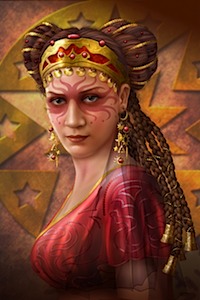By Terri C.
Ciro Marchetti is an award winning Professional Graphic Designer, who hails from the UK. He studied art in London. From there he worked in Europe and South America before settling in Miami, where he opened a design agency. He also gives workshops and lectures at Fort Lauderdale Art Institute. He recently took Grand Prize in the 2009 Worldwide Photoshop Competition.
Ciro began working on the Legacy of the Divine in October of 2006 and has clocked over 3000 hours with this deck project alone. He expanded from the artwork by creating his own historical origin and purpose for the Tarot, which is the subject of the gorgeous coffee table book that comes with the Special Edition. The “story” is also included in the paperback companion book that comes with the Standard Edition Deck and Book Set.
The other decks, created by Ciro, the Gilded Tarot and the Tarot of Dreams both made it into the Top 10 list in popularity on Aeclectic Tarot Forum, in their respective release years. The Gilded Tarot remains on the Top 10 List for All Time.
A common theme added to this Rider-Waite-Smith based trio of decks are Victorian brass survey devices, theodolytes and kaleidoscopes, which he collects and has taken some artistic liberty with. Ciro explains his thoughts of the origin behind the devices in the “story.”
I immediately fell in love with Ciro’s first deck, the Gilded Tarot, when it was released in 2004. That deck has been one of my primary reading decks ever since. It has been quite the delight to watch the subsequent projects unfold. I had the privilege of meeting Ciro in person at the ‘09 New York Reader’s Studio, where he joined my table for dinner.
The following interview was conducted via telephone on a very bright and sunny August morning.
T.C. Would you share the experiences that you’ve had that brought you from a Professional Graphic Designer to a Tarot Deck Designer?
C.M. I co-owned a design company that was started in the early ‘80’s in South America and eventually moved to Miami. It was a graphic design and marketing studio, where I spent a lot of time working with multi-national corporate clients. About 8 years ago, I informed my partner that I wanted to reduce my involvement and dedicate my efforts to my first love, namely producing my own illustrations.
As this involved a financial risk I discussed it with my wife who supported me and eventually I sold my stake in the company.
I sent out some samples of my work to various publishers, one of those was Llewellyn. I hoped there might be opportunities for producing book covers, calendars etc. Unfortunately they didn’t have any need for that at the time. (although two years later I did do a calendar for them). However they passed my work on to the "Divinations" department, where my work was seen by Barbara Moore. She contacted me with the initial suggestion of whether I would be interested in producing Tarot decks.
I had not even considered this before, I had almost no familiarity with Tarot beyond owning a couple of Marseilles styled decks, which I admired and looked at occasionally but never used. I did a little bit of research and I found the idea more intriguing, but advised Barbara of my lack of knowledge of the subject. She offered some encouragement saying that could be overcome as she saw potential and that the samples I had sent lent themselves to the genre.
T.C. How long does it take to create one card, from conception to completion?
C.M. That varies a lot from card to card, it seems to take longer over the years rather than shorter. The Tarot of Dreams is far more intense and intricate than the Gilded and Legacy of the Divine is even more so. I would say on average, about 40 hours, but that doesn’t allow for all of the modifications and changes that I would make. A lot get trashed before the 78 are finalized.
T.C. On average, how many revisions do you go through for each card?
C.M. Once again, there are variations on that. Sometimes I change the whole thing, and the final design is nothing like the original concept. That happens about 10% of the time. A lot of changes happen along the way, everything from color, layout, distribution, inclusion or exclusion of elements. Modifications can be both minor or elaborate. Sometimes though, I just hit it on the head first time out. It’s a cross section of all of those.
T.C. Your use of color is vastly different than other deck designers, what are your thoughts behind this?
C.M. The earlier decks, if one is referring to older classics, are more primary due to the print production process of those times. They were using spot colors, direct ink, so by default, they are flatter and in some cases more primary.
I like to play with light and shadow. I use it to add general ambience and mood, but also to focus attention on certain points, i.e. a key element or figure in the image. A source of light can also provide magical, spiritual, symbolic, emphasis. The source of that light can take multiple forms, ranging from sunlight entering through a window, candles, fire, sparkling gems or reflections on metal and water.
T.C. Do you think we will see more decks coming out with the vivid use of color, like you’ve chosen to use?
C.M. That’s very subjective and the preference of the deck creator. The medium that I use to produce my work, by painting on a digital tablet directly into a computer. This lends itself, by nature, to more experimentation. But ultimately it's a personal aesthetic choice, not a trend.
Go to Part Two Go to Part Three

